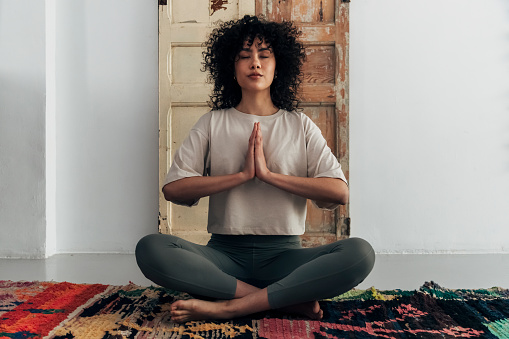What is yoga? And how it beneficial for the health
Yoga is a practice that has been used for thousands of years to promote physical and mental well-being. The practice involves a combination of physical postures, breathing techniques, and meditation. The benefits of yoga are numerous and can be experienced by people of all ages and abilities.
One of the most notable benefits of yoga is its ability to improve flexibility and strength. Yoga postures, or asanas, are designed to stretch and strengthen the muscles, tendons, and ligaments in the body. This can help to improve rathe nge of motion and reduce the risk of injury. Yoga also helps to improve balance and stability, which can be particularly beneficial for older adults who are at a higher risk of falls.
Notwithstanding its actual advantages, yoga is likewise known for its capacity to diminish pressure and advance unwinding. Yoga breathing techniques, such as pranayama, can help to slow down the heart rate and lower blood pressure, which can lead to a feeling of calm and relaxation. Meditation and visualization techniques can also be used during yoga practice to help reduce anxiety and promote a sense of inner peace.
Yoga has additionally been viewed as helpful for emotional wellness. Research has shown that regular yoga practice can help to reduce symptoms of depression and anxiety. Yoga may also help to improve mood, inand crease self-esteem and feelings of well-being. The combination of physical activity and mindfulness that yoga promotes, s believed to be the reason why it can be so helpful in improving mental health.
Yoga may also be beneficial for individuals with chronic pain conditions such as fibromyalgia, lower back pain, and osteoarthritis. Yoga postures can help to alleviate pain and improve range of motion, while yoga breathing and meditation techniques can help to manage stress and improve the over all quality of life.
Yoga is also beneficial for thrdiovascular health. It can help to lower blood pressure, improve circulation, and reduce the risk of heart disease. The combination of physical activity and relaxation can also help to lower levels of stress hormones, which can be beneficial for overall cardiovascular health.
In addition to its physical and mental health benefits, yoga is also known for its ability to improve the over all quality of life. Yoga can help to improve sleep, increase energy levels, and promote a sense of inner peace and well-being. It can also help to promote a sense of connection and community, as many people practice yoga in a group setting.
yoga is a practice that offers a wide range of physical and mental health benefits. From improving flexibility and strength, o reducing stress and promoting relaxation, yoga has something to offer foeryone. Whether you are looking to improve your physical health, manage a chronic condition, or simply find a way to reduce stress and promote well-being, yoga may be an excellent choice. It is a practice that is safe, effective, and accessible to people of all ages and abilities, making it a valuable tool for promoting overall health and well-being.
The mental and emotional benefits of yoga.
Yoga is a aining that joins actual stances, breathing activities, and contemplation or unwinding. It has been shown to have a severalental and emotional benefits, including:
- Reducing stress and anxiety: Yoga has been found to lower levels of the stress hormone cortisol and improve symptoms of anxiety.
- Improving mood: Yoga has been found to improve symptoms of depression and increase feelings of well-being.
- Improving self-esteem: Yoga can help individuals develop a positive body image and improve self-esteem.
- Enhancing cognitive function: Yoga has been found to improve attention, memory, and reaction time.
- Improving sleep: Yoga has been found to improve sleep quality, particularly in individuals with insomnia.
- Enhancing emotional regulation: Yoga can help individuals develop emotional regulation skills and improve their ability to cope with stress.
It’s important to note that most of the research on the benefits of yoga has been conducted on small sample sizes and more research is needed to confirm the benefits and understand how they work.
Types of Yoga:
There aris wide range of kinds of yoga, each with its owmarkable concentration and style. Here are some key points to consider when writing an article about the various types of yoga:
- Hatha yoga: This is one of the most popular and widely practiced forms of yoga. It focuses on physical postures and breathing exercises and is a good option for beginners.
- Vinyasa yoga: This type of yoga is characterized by flowing movements, linking breath with movement and building heat in the body. It’s a dynamic practice that can be challenging and energizing.
- Ashtanga yoga: This is an all the more genuinely requesting type of yoga that follows a set succession of stances. It’s a vigorous practice that emphasizes strength, flexibility, and endurance.
- Iyengar yoga: This type of yoga places a strong emphasis on alignment and precision in the postures. It’s a great option for people who are recovering from injuries or who have chronic pain.
- Restorative yoga: This type of yoga is designed to help relax and rejuvenate the body, using props such as blankets, bolsters, and blocks to support the body in the postures.
- Kundalini yoga: This type of yoga emphasizes the use of breath, movement, and meditation to awaken the energy of the body and mind. It’s a powerful practice that can be intense and transformative.
- Bikram yoga: This is a type of hot yoga that is done in a room heated to around 105°F (40°C). The practice consists of a set series of 26 postures and two breathing exercises.
- Yin yoga: This type of yoga is a slow-paced practice that emphasizes deep stretching and relaxation. It’s a great option for people who are looking to increase flexibility and reduce stress.
- Aerial yoga: This type of yoga utilizes a hammock-like fabric suspended from the ceiling to support the body in postures. It’s a fun and playful practice that can help improve balance and flexibility.



